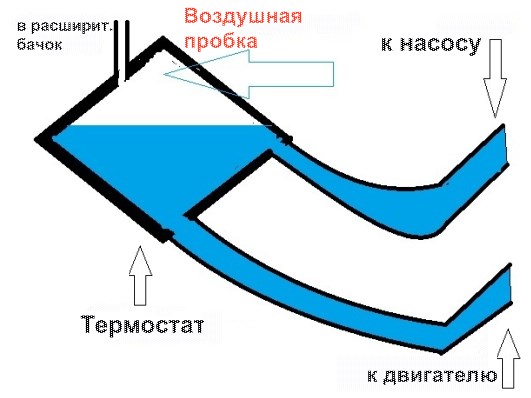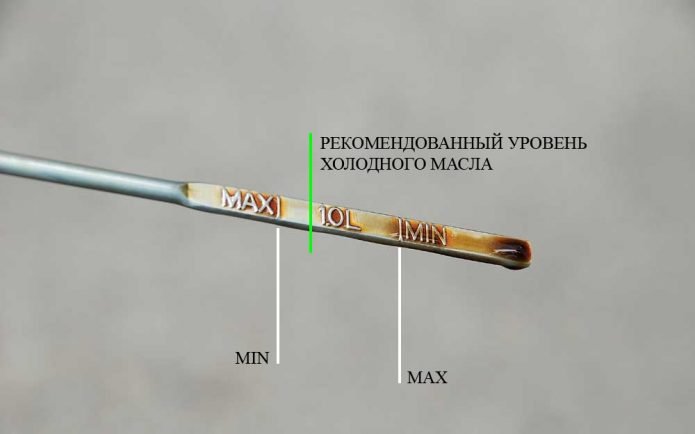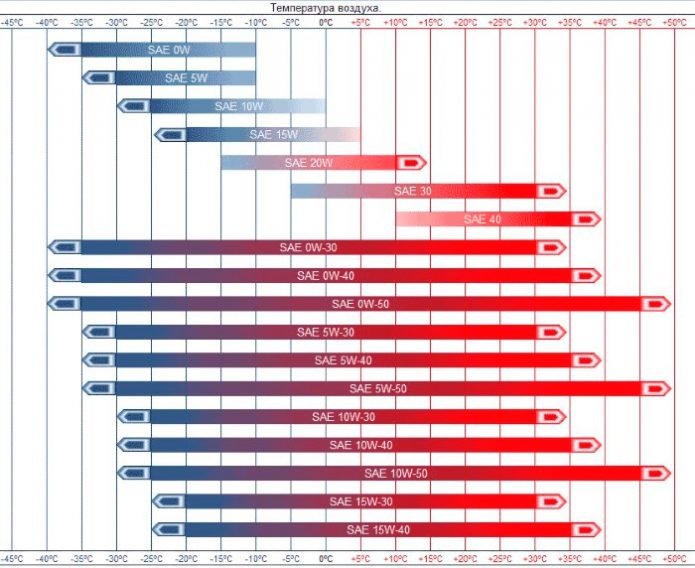
Oil pressure in a car engine
Content
The internal combustion engine of a car, as you know, consists of many moving parts in contact. Its work will be impossible without high-quality lubrication of all rubbing elements. Lubrication not only reduces friction by cooling metal parts, but also protects them from deposits that appear during operation. To ensure reliable operation of the engine, it is necessary that the oil pressure be maintained within the range specified by the designers in all modes. Insufficient or excessive oil pressure in the engine will sooner or later lead to its breakdown. In order to avoid big problems associated with expensive repairs, you need to identify the malfunction in time and immediately eliminate it.
Content
- 1 Oil pressure alarm
- 1.1 Check the alarm
- 2 Insufficient oil pressure in the engine
- 2.1 Reasons for lowering pressure
- 2.1.1 Low oil level
- 2.1.2 Untimely oil change
- 2.1.3 Non-compliance of the oil type with the manufacturer's recommendations
- 2.1.4 Video: motor oil viscosity
- 2.1.5 Video: oil viscosity - briefly about the main thing
- 2.1.6 Ingress of antifreeze, exhaust gases or fuel into the oil
- 2.1.7 Oil pump does not work
- 2.1.8 Normal engine wear
- 3 How to increase engine oil pressure
- 3.1 What additives to use to increase oil pressure
- 4 How to measure engine oil pressure
- 4.1 Table: average oil pressure in serviceable engines
- 4.2 Video: measuring oil pressure in a car engine
Oil pressure alarm
On the instrument panel of any car there is an emergency oil pressure indicator, in other words, a light bulb. It usually looks like an oil can. Its function is to instantly inform the driver that the oil pressure has dropped to a critical level. The signaling device is connected to the oil pressure sensor, which is located on the engine. In the event of an emergency oil pressure alarm, the engine must be stopped immediately. It can only be restarted after the problem has been fixed.
Before the light comes on, it may flash intermittently, which is also a sign of low oil pressure. It is better not to postpone the solution of this problem, but to immediately diagnose the malfunction.
Check the alarm
During normal operation of the engine, the indicator does not light up, so the question may arise, is it in good condition? It is very easy to check its work. When the ignition is switched on, before starting the engine, all signaling devices on the instrument panel light up in test mode. If the oil pressure light is on, then the indicator is working.
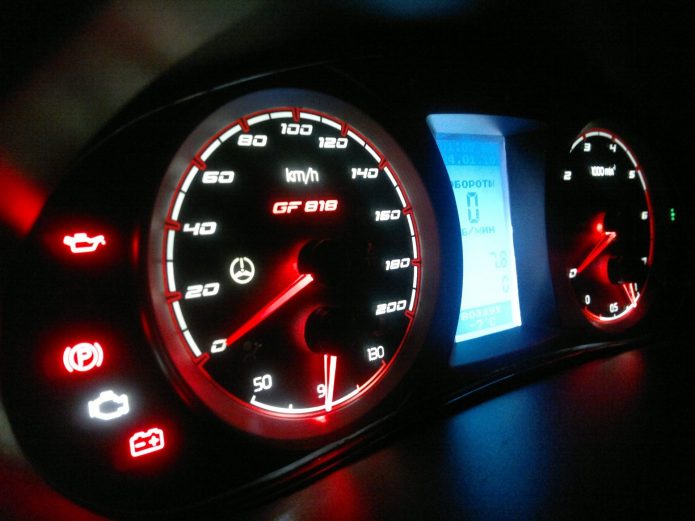
The instrument panel is in test mode when the ignition is turned on - at this moment all the lights come on in order to check their operation
Insufficient oil pressure in the engine
For a number of reasons, the oil pressure in the engine can decrease, which will lead to a condition where some engine parts receive insufficient lubrication, i.e. oil starvation. The engine will operate in a mode of increased wear of parts and eventually fail.
Reasons for lowering pressure
Consider the reasons that can lead to a decrease in oil pressure.
Low oil level
An insufficient oil level in the engine leads to a decrease in its pressure and the occurrence of oil starvation. The oil level must be checked regularly, at least once a week. To do this, the engines have a special probe with an acceptable level scale.
- Place the car on a level surface so that there is no measurement error. It is good if the car is in a garage with a flat floor.
- Stop the engine and wait 3-5 minutes for the oil to drain into the oil pan.
- Take out the dipstick and wipe it with a rag.
- Insert the dipstick into place until it stops and pull it out again.
- Look at the scale and determine the level by the trace of oil on the dipstick.

It is advisable to maintain such an oil level in the engine that its mark on the dipstick fills approximately 2/3 of the distance between the MIN and MAX marks.
If the oil level in the engine is too low, it must be topped up, but first inspect the engine for leaks. Oil can flow from under any connection of parts: from under the oil pan, crankshaft oil seal, gasoline pump, oil filter, etc. Engine housing must be dry. The detected leak must be eliminated as soon as possible, while driving a car should only be done when absolutely necessary.
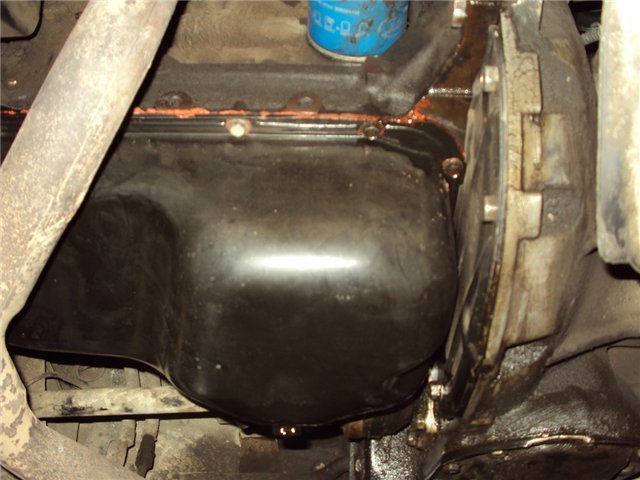
Oil can leak anywhere in the engine, such as from a damaged oil pan gasket.
Old worn engines often suffer from the problem of oil leakage, which is called "out of all the cracks." In this case, it is very difficult to eliminate all sources of leakage, it is easier to overhaul the engine, and this, of course, will not be cheap. Therefore, it is better to constantly monitor the oil level, add it if necessary, and troubleshoot at the first symptoms of a leak.
Untimely oil change
Engine oil has a certain resource of use. As a rule, it fluctuates in the range of 10-15 thousand kilometers, but there are exceptions when the oil needs to be changed more often, depending on the requirements of the manufacturer and the condition of the engine.
Modern engine oil plays an important role in the operation of the engine, it reliably protects all parts, removes heat, wear products from rubbing parts, and removes carbon deposits. The oil contains a number of additives designed to enhance certain of its properties in order to make engine protection even more reliable.
During operation, the oil loses its qualities. A grease that has exhausted its resource contains a large amount of soot and metal filings, loses its protective properties and thickens. All this leads to the fact that the oil may stop flowing through narrow channels to rubbing parts. If the car is little used and the recommended mileage has not been passed during the year, the oil should also be changed. The chemical properties of oils are such that with prolonged interaction with the engine material, they also become unusable.
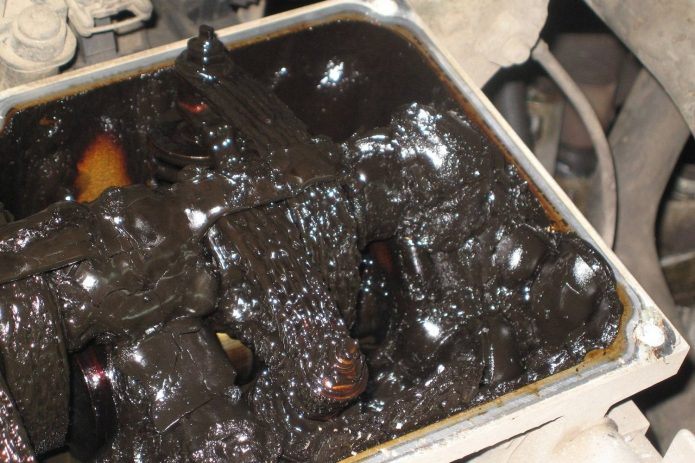
The oil thickens in the engine as a result of long-term operation, far exceeding the allowable resource
The deterioration of oil quality and increased engine wear are processes that contribute to each other's aggravation. That is, poor oil, which lubricates the parts poorly, leads to their increased wear, and during wear, a large amount of metal chips and deposits appear, further polluting the oil. Engine wear is growing exponentially.
Non-compliance of the oil type with the manufacturer's recommendations
Engine oil must exactly match the mechanical, thermal and chemical effects that the engine has on them during operation. Therefore, motor oils are divided into several types according to their purpose:
- for diesel or gasoline engines, there are also universal products;
- mineral, semi-synthetic and synthetic;
- winter, summer and all-weather.
Engine manufacturers recommend certain types of oil for use in each of them, you must strictly adhere to these recommendations. Information on the type of oil can be found in the vehicle's operating instructions or on a special plate in the engine compartment.
Without exception, all oils have such a physical parameter as viscosity. It is usually indicated as a recommendation. Viscosity is a property of an oil that depends on the internal friction between its layers. In the process of heating, the viscosity is lost, i.e. the oil becomes liquid, and vice versa, if the oil is cooled, it becomes thick. This is a very important parameter that is set by the engine manufacturer, taking into account the technological gaps between the rubbing parts and the size of its oil channels. Failure to comply with this parameter will certainly lead to poor-quality operation of the lubrication system and, as a result, engine failure and failure.
For example, we can cite the manufacturer's recommendations for choosing engine oil for a VAZ 2107 car. According to the service book, lubricants with different SAE viscosity grades should be used depending on seasonal fluctuations in ambient temperature:
- 10W-30 from -25 to +25 ° C;
- 10W-40 from -20 to +35 ° C;
- 5W-40 from -30 to +35 ° C;
- 0W-40 from -35 to +30 ° C.

Each type of oil viscosity is designed for a certain range of ambient temperatures
The oil pressure in the engine directly depends on the compliance of the type of oil used with the manufacturer's recommendations. Too thick oil will not pass well through the channels of the engine lubrication system, designed for thinner. Conversely, too thin oil will not allow you to create working pressure in the engine due to its excess fluidity.
Video: motor oil viscosity
In order to avoid problems with oil pressure, the following rules should be followed:
- use the recommended type of oil from a reliable and trusted manufacturer;
- change the oil no later than the period or mileage recommended by the manufacturer, and even more often under increased vehicle operating conditions;
- change the oil more often in engines with high mileage. Such engines have increased clearances in the cylinders, so the oil has to collect more soot and soot, respectively, it runs out of its resource earlier;
- be sure to install a new oil filter along with the oil change;
- do not mix different brands of oil, even of the same type. Oil manufacturers use additives of different chemical properties, which can lead to a chemical reaction and loss of their quality properties. The oil may even begin to foam, and this is absolutely unacceptable for the engine;
- you should not flush the engine once again after draining the used oil if you are going to fill in oil of the same brand and in due time. Flushing can lead to a violation of the protective layer on the surface of parts created by special additives in the oil;
- you should not use additional additives without the need, this can disrupt the work of a balanced set of elements added to the oil by the manufacturer.
Video: oil viscosity - briefly about the main thing


Watch this video on YouTube
Ingress of antifreeze, exhaust gases or fuel into the oil
The ingress of fluid from the cooling system or exhaust gases into the engine lubrication system is possible in case of damage to the cylinder head gasket.
There are times when fuel gets into the oil due to the failure of the fuel pump membrane. To determine the presence of gasoline in the oil, it is necessary to carefully examine a drop of oil from the engine; characteristic iridescent stains should be visible on it. In addition, the exhaust gases will smell like gasoline. Be careful, inhaling exhaust gases is not safe for your health.
Diluted with a foreign liquid, moreover, chemically active, or exhaust gases, the oil will immediately lose viscosity and other important properties. Exhaust pipe will emit white or blue smoke. It is highly undesirable to operate the car in this case. After the malfunction has been eliminated, the oil in the engine must be replaced with a new one, after washing the motor.
The cylinder head gasket also cannot break through on its own, most likely this is the result of engine overheating, detonation of low-quality fuel, or the result of tightening the head bolts with the wrong force.
Oil pump does not work
It is not uncommon for the oil pump itself to fail. Most often, its drive breaks. If the pump drive gear is torn off while driving, the oil pressure will drop sharply and the emergency oil pressure indicator will immediately inform the driver about this. Further operation of the car is prohibited, because in this case the engine will work for a very short time. Overheating of parts will occur, the surface of the cylinders will be scuffed, as a result, the engine may jam, respectively, a major overhaul or replacement of the engine will be required.
Natural wear of the pump is also possible, in which case the oil pressure will drop gradually. But this is an extremely rare case, because the resource of the oil pump is very large and it usually lasts until the engine is overhauled. And during the repair, the master minder must check its condition and replace it if necessary.
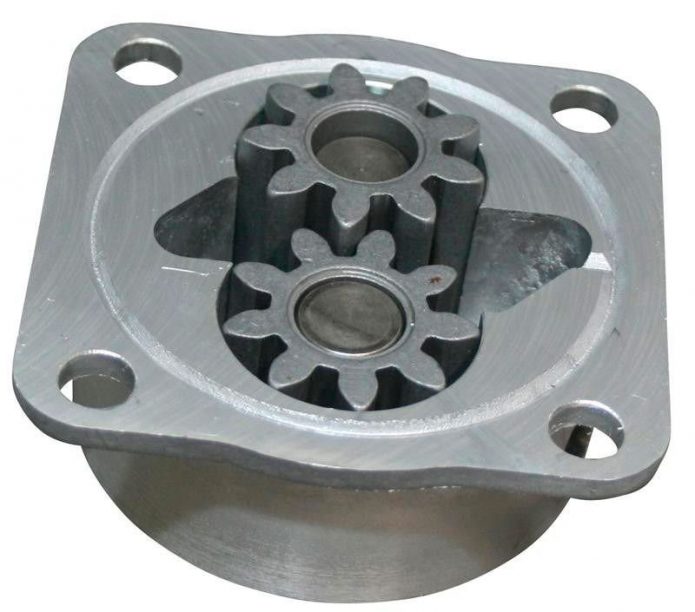

The gear-type oil pump has a simple and reliable design, so its resource exceeds the life of the engine before overhaul
Normal engine wear
An internal combustion engine has a certain resource, which is measured by the car's mileage in kilometers. Each manufacturer declares a warranty mileage of the engine before overhaul. During operation, engine parts wear out and technological gaps between rubbing parts increase. This leads to the fact that soot and deposits coming from the combustion chamber of the cylinders get into the oil. Sometimes the oil itself seeps through worn oil scraper rings into the combustion chamber and burns there along with the fuel. You can often observe how the exhaust pipe of old cars smokes very strongly with black smoke - this is oil burning. The service life of oil in worn engines is greatly reduced. The motor needs to be repaired.
How to increase engine oil pressure
To restore the desired oil pressure in the engine, it is necessary to eliminate the causes of its decrease - add or replace oil, repair the oil pump or replace the gasket under the cylinder head. After the first signs of a drop in pressure, you should immediately contact the master for a more accurate diagnosis. These signs may be:
- motor overheating or unstable operation;
- loss of power;
- oil leakage from the engine;
- strong smoke from the exhaust pipe of a gray, white or black color;
- operation or flashing of the emergency oil pressure indicator.
The reason for the drop in pressure can be very difficult, or rather, not cheap. We are talking about engine wear during operation. When it has already passed its resource and needs repair, unfortunately, except for a major overhaul, it will not be possible to solve the problem with low oil pressure in the engine. But you can take care in advance that the oil pressure in an already worn engine remains normal. Today, there are a number of additives on the automotive chemicals market designed to eliminate slight engine wear and restore factory technological gaps between rubbing parts.
What additives to use to increase oil pressure
Engine additives are available in various types:
- restoring - the so-called metal conditioners, designed to restore damaged surfaces of rubbing parts and remove microcracks. They form a protective layer on the surface of engine parts;

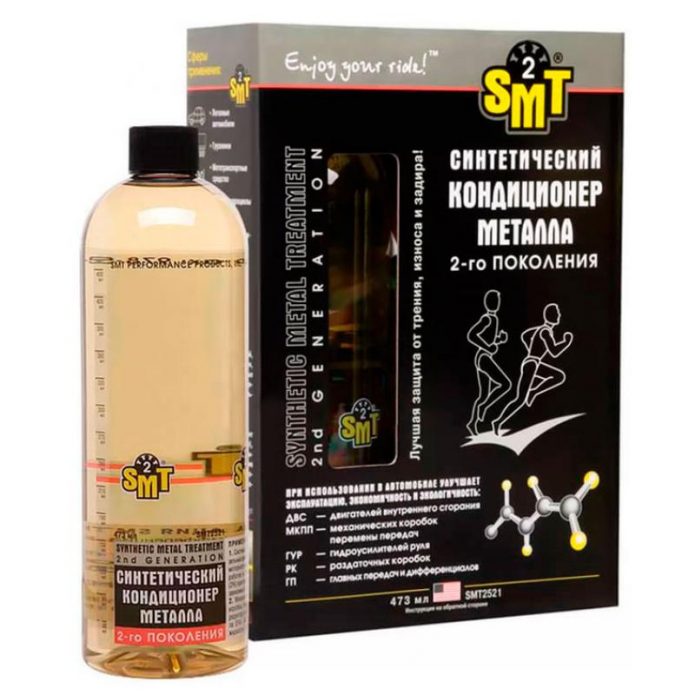
To increase the oil pressure in the engine, you can use restorative additives - metal conditioners
- fuel-saving - to save fuel;
- stabilizing - designed to restore the viscosity of the oil at high temperatures and balance the additive package in the oil, if it is used in the engine at high loads;
- detergents - help to remove hardened deposits and soot.
To increase the pressure, restoring and stabilizing additives should be used. If the engine is not badly worn, they will help. Of course, you should not expect a miracle, additives raise the pressure slightly and their effect is highly dependent on engine wear.
The new motor does not need additives, everything is in order in it. And so that they are not useful in the future, you need to change the oil in a timely manner and use only high-quality products that already contain a package of additives that positively affect the operation of the motor. This is expensive, but useful, because it will only positively affect the engine of your car. There is a lot of controversy and various opinions around the use of additives - someone claims that they help, others say that this is a hoax and a marketing ploy. The right decision for owners of a new car will be careful operation and overhaul after the end of the engine life.
How to measure engine oil pressure
Some vehicles are equipped with a fixed gauge that displays the operating oil pressure on the instrument panel. In the absence of such, it is necessary to use a special pressure gauge. In order to measure the oil pressure, it is necessary to carry out the following operations.
- Warm up the engine to an operating temperature of 86–92 °C.
- Stop the engine.
- Unscrew the emergency oil pressure switch from the engine block.

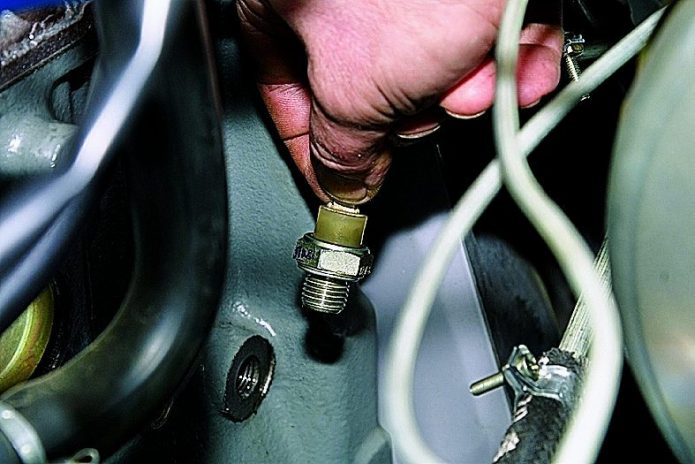
The sensor is completely unscrewed from the motor housing after the wire is disconnected from it
- Install the pressure gauge hose using the adapter instead of the oil pressure sensor.

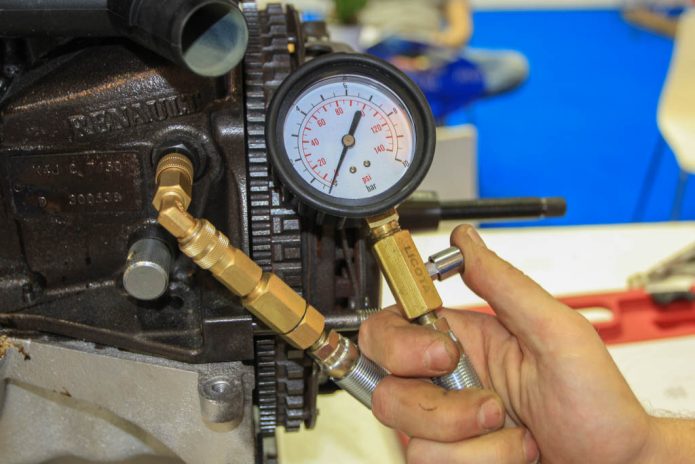
The pressure gauge fitting is installed instead of the unscrewed emergency oil pressure sensor
- Start the engine and at idle measure the oil pressure.
- Varying the crankshaft speed to medium and high, record the pressure gauge reading at each stage.
Oil pressure varies in engines of different models, so the range of its performance must be sought in the technical literature for a particular car model. But if those are not at hand, you can use the averaged data corresponding to the normal operation of the engines.
Table: average oil pressure in serviceable engines
| Motor characteristic | Indicators |
| 1,6L and 2,0L engines | 2 atm. at speeds XX (idling), 2,7–4,5 atm. at 2000 rpm in min. |
| 1,8 l engine | 1,3 atm. at speeds of the XX, 3,5–4,5 atm. at 2000 rpm in min. |
| 3,0 l engine | 1,8 atm. at speeds of the XX, 4,0 atm. at 2000 rpm in min. |
| 4,2 l engine | 2 atm. at speeds of the XX, 3,5 atm. at 2000 rpm in min. |
| TDI engines 1,9 l and 2,5 l | 0,8 atm. at speeds of the XX, 2,0 atm. at 2000 rpm in min. |
Accordingly, if the indicators go beyond those given in the table, then it is worth contacting a specialist or taking actions to eliminate the malfunction on your own.
Before starting repairs, the oil pressure must be measured to make sure that the primary signs were correct.
Video: measuring oil pressure in a car engine


Watch this video on YouTube
Motor oil can be compared to blood in a living organism - it plays a fundamental role in the functioning of all organs, just like oil for mechanisms in a car engine. Carefully monitor the condition of the oil in the engine, check its level regularly, monitor the impurities of chips, control the car's mileage, fill in oil from a trusted manufacturer and you will not experience problems with oil pressure in the engine.
